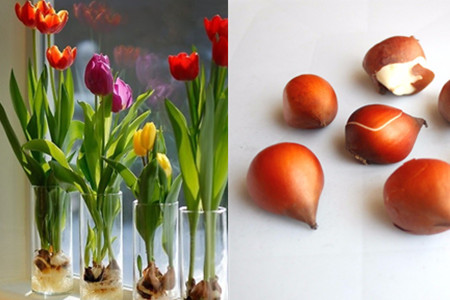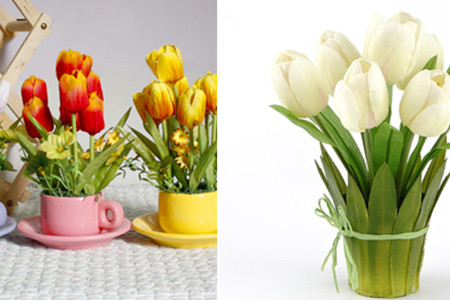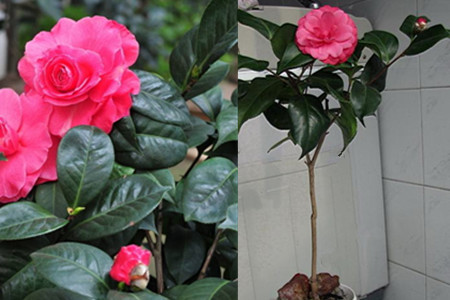The method of hydroponic culture of tulip bulbs can grow better by changing water in time.

Tulips can be regarded as a relatively common plant, its flowers are like wine glasses, there are red, yellow, purple, white, and now there is even a flower with two or three colors distributed at the same time. This plant was first grown in Europe, then spread to us, and now it has become an important member of the florist, selling tens of thousands of flowers every day. And it is loved not only because of its gorgeous flowers, but also because it is easy to breed.
This kind of plant usually propagates by dividing its roots, and its roots grow like a larger, round clove of garlic, so it is often called "planting ball". Generally speaking, there are only two ways to grow it, one is planted in the soil, the other is put in the water. Next, let's introduce how to hydroponically cultivate it.
1. Select the seed ball
Friends before planting, be sure to carefully select the seed ball, because some can not use hydroponics this method. When choosing, try to choose those that are round and hard to use.
2. The selection of pots.
In the choice of pots can not be too random, can not choose those too deep, because this kind of ball is easy to rot; can not choose those too shallow, so that there is not enough room to grow.
3. Change the water in the utensils frequently
If friends want their plants to grow more and stronger roots, they need to change the water frequently to ensure that they can get enough nutrients.
Although this kind of plant can blossom relatively early through hydroponics, it is still relatively complicated to operate.
How to hydroponically cultivate Tulip bulb and Preservation method
With the continuous development of technology, tulips can also be hydroponically cultivated, so that they can be placed in the middle of the home to make them more beautiful and tidy. However, many people do not know much about how to cultivate tulips in water. Today, I will tell you about the methods of hydroponic culture of tulips and the preservation of tulip bulbs.
How to cultivate tulips in water
1. Seed bulb selection: selecting a suitable and disease-free seed bulb is the key to the hydroponic production of cut tulip flowers. Hydroponic tulips need to be cold treated. The temperature is controlled at 9 ℃ before the end of October, and the temperature is kept at about 2 ℃ from December to January, and the humidity is 85-95%.
2. Planting method:
① chooses and determines the cultivation time and planting method according to the time it takes. For hydroponic cut flower cultivation, the bulb should be planted in a sterilized and watertight needle plate to stabilize the rooting temperature at 8 ℃ and the humidity between 60% and 70%.
② takes root for about two weeks, make sure the root is more than 3 cm long, and transport the needle plate to the greenhouse. The relevant conditions of the greenhouse are as follows: the humidity is 60%-70%, the EC value in the water is 1.5ms to 2.0ms, and the temperature is controlled at 15-20 ℃, which is beneficial to the rapid growth of tulips.
③ is very susceptible to diseases at the initial stage of growth, so in order to prevent diseases caused by filamentous bacteria, it can be sprayed 2 to 3 times. Low toxicity, topiramate, high efficiency chlorothalonil, trimethoprim and so on were selected, and the concentration was between 750 and 1000 times.
According to the growth condition, ④ sprays foliar fertilizer timely to coordinate vegetative growth and reproductive growth. In the process of growth, due to the action of root exudates and other environmental conditions, a layer of oil film will be produced on the water surface of the needle disk, which will make the root lack of nutrient supply and cause the root system to be brown. Therefore, change the water for 2 to 3 times as appropriate.
3. Culture medium: the planting plate is placed in a rooting chamber with a small amount of air flow at a temperature of 5 ℃. Tap water with a conductivity of 1.5ms/cm or Rain Water can be used. For varieties prone to leaf cracking, water with a conductivity of 2ms/cm should be used in the rooting stage.
4. Maintenance: when the tulip root grows to 100px, put the planting plate on the flat ground in the greenhouse to remove the susceptible or ungerminated bulbs. At this stage, make sure that the water level reaches the overflow outlet, the temperature is maintained at 16-18 ℃, and the humidity is maintained at 60-80%. The frequency of watering at the end of planting can be reduced to half of that before harvest, and enough water should be provided to the plant before harvest to prolong the flowering period of tulips.
Preservation method of Tulip bulb
Don't take out the bulbs immediately after the flowers fade, wait for the stems and leaves to decay naturally. The specific methods are as follows:
Trim:
After the flower fades, cut it 2-3 cm below the flower. Keep the leaves and don't cut them too long.
Maintenance:
Water normally and apply a small amount of fertilizer. Pay attention to rainy days, do not wind and rain, so as not to rot the roots.
Stop water and fertilizer in September, put the plant in the shade and dormancy naturally.
Storage:
All the leaves and stems turn yellow in October. Dig out the bulbs before the rainy season, remove all the stems and leaves that you want to keep up with, and be careful not to hurt the bulbs.
You can find a large box filled with sand, put a layer of plastic film on the bottom to avoid leakage, put the bulb in, put the box in a cool and dry place, leave the box open and open. The soil in the box should not be too dry, but spray some water appropriately. Or take out the bulbs and wrap them in a thick layer of newspaper and put them in the freezer.
In November, take out the bulb and buy it into the ground. Don't put it in the sun at first, but a week later, move to the sun and take care of it normally.
Note:
After low temperature treatment, it is easier to bloom than other bulbs, but it can still blossom repeatedly. Did not bloom, appear dumb flower phenomenon, the temperature may be too high. At this time, the ball must be preserved so that it can blossom year after year!
After the flower fade, it is necessary to fertilize and water frequently, so as to promote the development and growth of the rhizome and be more conducive to the preservation of the bulb. Compared with sowing and propagation, directly planting bulbs is better to maintain and blossom faster.
The above is for everyone to introduce the tulip hydroponic method, as well as the tulip bulb preservation method, I hope it can help you, more household knowledge please pay attention.
Family planting and hydroponic cultivation of tulips Tulip is a bulb flower that is planted in autumn and blossoms in spring. It likes to be cool and afraid of heat. Under natural conditions, it is most suitable to plant about 10 ℃ at 15 cm underground in autumn, because this temperature is suitable for root growth, which is around "National Day" in North China and from late October to early November in the middle and lower reaches of the Yangtze River. Before the arrival of cold winter, good root development is very important for the good growth of the following spring. In winter, the planted bulbs develop further at low temperature, break dormancy through a long winter low temperature, sprout in early spring, spread leaves and blossom with the rise of temperature. Usually, tulips planted by families are imported bulbs bought from the flower market, and they are generally treated with low temperature. They are usually bulbs that have been treated with 5 ℃ or 9 ℃ for 2 to 3 months, commonly known as "5 ℃ balls" and "9 ℃ balls", which can be planted directly. Pot soil can use fertile sandy soil, peel off the hard yellowish-brown crust outside the bulb before planting, which is beneficial to the growth of roots. 2/3 of the bulbs are buried in the soil and placed in the environment of 7 ℃ to 10 ℃. This temperature is conducive to root formation, but not conducive to bud growth and pathogen reproduction. If the temperature is lower, the root system forms slowly, and the later stem and leaf growth is delayed. If the temperature is high, the stem and leaf grow early before the root system is formed, which is easy to produce blind flower phenomenon, that is, it only grows buds but does not blossom. In the rooting stage, without light, it can be put into a carton and placed in a closed balcony with a temperature of about 9 ℃. After the formation of the root system, it can be moved into the indoor light to promote the growth and flowering of stems and leaves. If the room temperature is more than 20 ℃, the light is weak, and it is easy to grow. It is more suitable to bloom in 15 ℃ to 20 ℃, which usually blossoms in about 1 month, which depends on the variety planted. If the seed balls bought have not been treated with low temperature, they should be planted with reference to the way of planting balls without low temperature treatment. after potted in autumn, the flowerpot can be buried in the outdoor ground and covered with soil of 10 centimeters. Generally, the flowerpot can be taken out in January and cultivated indoors. It can blossom in January or so. The nutrition needed for the growth and flowering of tulips mainly comes from the bulbs, and the formation of bulbs depends more on the nutrients in the soil, so the quality of bulbs is also important if you want to get plants with strong flowers. Generally speaking, if the perimeter of the seed ball is greater than 10 cm, it is of high quality, which should be paid attention to when choosing and buying the seed ball. Of course, whether there is any damage in the root disc should also be paid attention to when selecting the seed ball. Potted tulips can be fertilized in time after flowering, promote their growth and promote the formation of new seed balls. The hydroponic culture of tulips is also carried out according to the growth habits of tulips. As hydroponic tulips are disposable bulbs, it is more important to buy high-quality bulbs, and the bulbs must be treated at low temperature. Fill the vase or other container with water, put the seed ball into the mouth of the container, soak half of the seed ball, and then put the hydroponic container in an environment of 7 ℃ to 10 ℃ to promote rooting. After the root system is formed, it will take about 15 to 20 days to move into the indoor light. Due to the rapid consumption of water in the rooting stage, the loss of water should be checked every 2 to 3 days to replenish water in time to prevent the root from drying up due to water loss. If the bulb is small, you can also supplement some nutrient solution, which can contain 0.15 grams of nitrogen, phosphorus and potassium compound fertilizer per liter plus the same amount of calcium nitrate. If there is no calcium nitrate, only compound fertilizer can be used. In the stage of hydroponics, half of the water or nutrient solution can be changed every 3 to 4 days. If all the water is renewed at once, the root is easy to grow slender and not strong.
- Prev

How to grow tulip seeds to teach you three steps to grow healthy plants
Tulips are herbs of the genus Tulipa in the Liliaceae family, native to Central Asia and the Mediterranean coast. Tulips are a popular ornamental plant with many varieties and colorful flowers, but few people know how they are grown
- Next

How to hydroponically cultivate camellias can easily survive? the five cultivation steps must be done well.
The flowers of camellias are full and gorgeous, and it is really suitable to decorate the environment with it. Most of the friends who like to cultivate camellias indoors choose the way of hydroponics. So, when conducting hydroponic culture of camellias, what should be done to make them survive quickly?
Related
- Fuxing push coffee new agricultural production and marketing class: lack of small-scale processing plants
- Jujube rice field leisure farm deep ploughing Yilan for five years to create a space for organic food and play
- Nongyu Farm-A trial of organic papaya for brave women with advanced technology
- Four points for attention in the prevention and control of diseases and insect pests of edible fungi
- How to add nutrient solution to Edible Fungi
- Is there any good way to control edible fungus mites?
- Open Inoculation Technology of Edible Fungi
- Is there any clever way to use fertilizer for edible fungus in winter?
- What agents are used to kill the pathogens of edible fungi in the mushroom shed?
- Rapid drying of Edible Fungi

